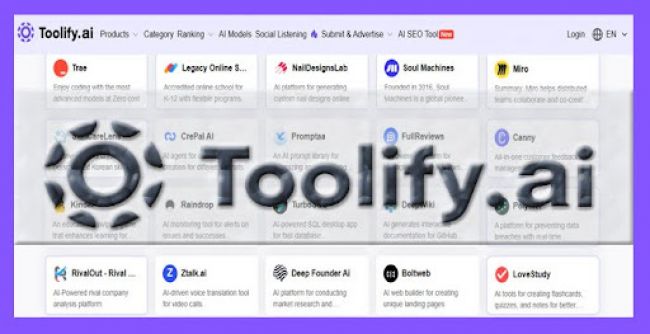Software
5 min read
Toolify.ai Explained: What You’ll Find Inside This AI Tools Directory


Explore Toolify.ai’s 230+ AI tool categories, filters, GPTs, and add-ons. Learn its strengths, limitations, and what users are saying in 2025.
Toolify.ai has become one of the largest AI tool directories, cataloging thousands of apps across 230+ categories. But unlike editorial platforms such as hands-on Luma AI review or Winston AI’s watchdog analysis, Toolify doesn’t test, rate, or compare tools. Instead, it acts like a map of the AI landscape—organized, filterable, but without guidance on quality.
This article breaks down Toolify’s sections, features, and limitations so you know what it does and doesn’t do.
At the core of Toolify is its directory, with tools grouped by function:
Each listing includes a short description + a direct link to the official tool. No sign-up is needed—just click and explore.
This model resembles a catalog more than a review site, meaning it’s great for discovery but weak for decision-making.
Two of the most visible sections are:
These signals measure interest, not quality or satisfaction. As one Reddit SaaS thread points out, high traffic doesn’t always mean high retention or usefulness.
Toolify offers several filters that show patterns in AI tool usage based on different factors. These include:
These filters are helpful for trend-spotting, but should be treated as external data snapshots, not verified benchmarks. For deeper, tested reviews, sites like ProductHunt’s Toolify review board often provide more grounded insights.
The “New” page lists tools that were recently added to Toolify. This section helps users find projects that have just launched or are starting to gain visibility.
There’s also a filter for recently updated tools, though the nature of the updates isn’t always clear from the listing alone.
This area is often used by early adopters who want to discover new tools before they become widely known.

Two additional sections offer specialized tool categories:
These sections are not technical deep dives—they’re just for classification and navigation.
Anyone who has built an AI tool or GPT can submit it to Toolify. There’s a form for submitting listings, with optional promotional features for added visibility. While many tools are listed for free, the promoted spots likely require payment.
Toolify does not publish how submissions are reviewed or how long they remain on the site.
It’s important to note what Toolify does not do:
This makes Toolify more of a catalog than a guide. It’s useful for discovering what’s available but not for deciding what’s worth using. That part is left entirely to the user.
| Pros | Cons |
|---|---|
| Huge catalog (230+ categories) | No tool evaluations |
| Easy to use, no login needed | Quality/accuracy not verified |
| Shows usage trends | Traffic ≠ satisfaction |
| Custom GPT + extension listings | Update transparency unclear |
Toolify.ai is a large and organized directory of AI tools. It shows traffic trends, categories, and availability of tools across different formats (web, app, extension, GPT). What it doesn’t do is evaluate or recommend tools. It simply displays what exists.
If you’re trying to get an overview of the AI landscape, or want to quickly see what’s new in a certain category, Toolify can be a helpful starting point. But like with any third-party listing, it's up to you to verify tools before using them.
Is Toolify.ai Reliable for Finding AI Tools?
Yes, Toolify is reliable as a directory because it lists tools accurately with links to official sites. However, it does not verify quality or performance.
How Accurate Are Toolify’s Usage Metrics?
The “Most Used” and “Most Saved” data reflect traffic and bookmarking trends, not user satisfaction. They’re good for spotting interest, not tool quality.
Toolify vs. Review Platforms: What’s Missing?
Unlike review sites, Toolify provides no ratings, comparisons, or testing. It’s a catalog for discovery, while review platforms help with evaluation.
Community Feedback: What Users Say About Toolify
On Reddit and ProductHunt, users appreciate the breadth of listings but note the lack of editorial depth or quality checks.
Be the first to post comment!